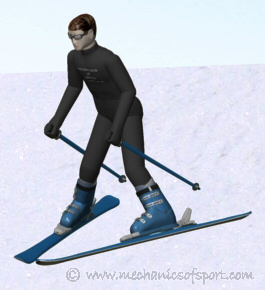Dealing with Inconsistent Snow
Dealing with variability on the slopes – sun-affected, wind-affected, inconsistent crust!

Imagine skiing through this! Photo credit: Nicky Corbishley
It’s such a torturous sight, seeing a field of powder slowly get cooked under the sun, rendering the once-fluffy surface into a thick helping of mashed potatoes. Unlike Grandma’s famous tots, not only is skiing through sunbaked and settled snow not an enjoyable experience, but it can also be a dangerous one. In keeping with the potato theme, it’s like a shepherd’s pie, just not a tasty one – the top layer is a crust that, instead of giving way to a delicious filling, gets the skis moving disproportionately quickly through the unpacked layer of snow underneath. Snowboarders, you’re lucky here as the width and reduced number of edges tend to make it more suited for these conditions. For skiers, it can be doubly hard to keep the weight centered, as the crust can be weaker or stiffer from leg to leg, and across the width of the slope.
Sounds like a lot to keep track of, right? And what’s one to do on days like this? For starters, you can avoid runs like this altogether! We’ve covered in the past what fun groomers can be, and it is never a bad day to work on your technique. That’s right – some days are just not for the trees and the steeps.
But what happens if say, you arrive at a run that was perfect in the morning until the sun hit? Or what if you take a wrong turn? Wrong turns happen to the best of us, though, and you might find that one of your wrong turns leads you to a situation with snow like this, where you don’t really have much of an option other than hiking back out the way you came. Not only is hiking out a pain in the butt, but you’re going to waste a ton of energy post-holing, when instead, if you had just a couple simple techniques to work with, you can get down it without too much issue.
The Traverse
The first tip on how to get down the inconsistent snowpack better is to make the terrain more manageable, by cutting it into lateral slices. You can make a slope steeper or gentler depending on the angle at which you are descending. Making a nice, long traverse helps you govern your speed, and you can always point your skis/board uphill against the fall line if you feel you’re gaining too much speed. If the snow is especially grabby, it’s not the worst thing to walk/shuffle through it, as your main focus should be on maintaining your balance without getting pitched forward.
The Snowplow

Excellent image demonstrating the ideal snowplow technique
The second tip is to make use of the snowplow! Far from being just something for beginners, the snowplow is quite possibly the most useful technique you can employ on the mountain. While it’s a quad workout for those not used to it, it’s the easiest way to regulate your speed going down the mountain. If you’re faced with punching through a sheet of encrusted, unforgiving snow, the snowplow has the double effect of, yes, you got it – shoveling the snow out of the way as you progress down the hill, and the stance itself helps you keep your balance. While a long snowplow trail can be irritating to see on chutes, glades and other steeps, there is certainly a time and place for it, and crust-busting fits into that description.
The Escape
Combining the two techniques can get you down most runs, but there are also times where the best call is to say ‘screw this, I’m not going to waste my effort and possibly injure myself by going down this run’ – maybe it’s 3:50 pm and your legs are shot, or maybe it’s a little fresh snow that drew you into a hulking field of hard uncertainty. Whatever the case, it’s good to get an understanding of what runs surround the one you’ve chosen. There’s no shame in exiting the run via the trees, just make sure you don’t get yourself cliffed out, accidentally! No one likes to see that.
Beyond those tips, it’s good to arrive at the mountain with an idea of what the recent weather has been like. A week of snow every day goes a long way towards removing some of these impediments, but as we enter spring, the sun will have its say as well in determining the conditions. We are in luck, as a few major storm cells are coming through in the end of February/early March.
Be sure to check with us first for deals on tickets, lodging, and gear, so you’ll be ready to get after it, regardless of the conditions!
Further Reading
- Relive Your Youth by Going Totally Tubular | 3 min. read
- Want to Avoid Crowds? Ski Independent. | 4 min. read
- Alternative Ski Methods | 4 min. read
Featured Resorts

Killington Resort

Pico Mountain

Mammoth Mountain

Palisades Tahoe

Arapahoe Basin

Aspen Snowmass

Sugarloaf

Sunday River

Big Sky

